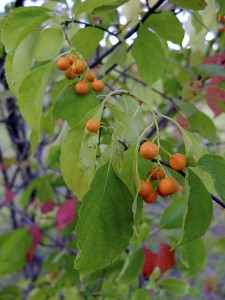American bittersweet (Celastrus scandens) is a widespread and, in Minnesota, fairly common woody vine. Unlike most vines it does not produce tendrils or aerial roots. It climbs by growing spirally from left to right up a tree or other adjacent vegetation. In the fall the bright orange fruit coverings splits open into three parts and folds back to reveal 3 to 6 bright red, berry-like seed coatings. The fruits remain on the vine through the winter, adding interest to the colorless landscape. They are poisonous to humans but not to birds.
American bittersweet is similar in appearance to the exotic invasive Oriental bittersweet. The best way to identify them is by leaf shape, location and number of flowers, and fruit color. American Bittersweet has leaves that are often twice as long as wide; clusters of 5 to 60 flowers at the ends of branches; and orange fruit capsules. Oriental bittersweet has broader, sometimes almost round leaves; clusters of 2 to 7 flowers in leaf axils; and yellow fruit capsules.
http://www.minnesotaseasons.com/Plants/American_bittersweet.html


In my research to ID my photos of American bittersweet, I learned that Oriental bittersweet is considered an ecological threat in MN, and any DEFINITIVE sightings of it should be reported to the State. More information is found on the MN DNR website: http://www.dnr.state.mn.us/invasives/terrestrialplants/woody/oriental_bittersweet.html
In addition, the MN Department of Agriculture has declared Oriental bittersweet as a “prohibited noxious weed on the eradicate list,” and it also cannot be sold, transported, or propagated, per Minnesota statute: http://www.mda.state.mn.us/en/plants/badplants/orientalbittersweet.aspx
Tiens jje comptais rédiger unn post identique
à celui ci